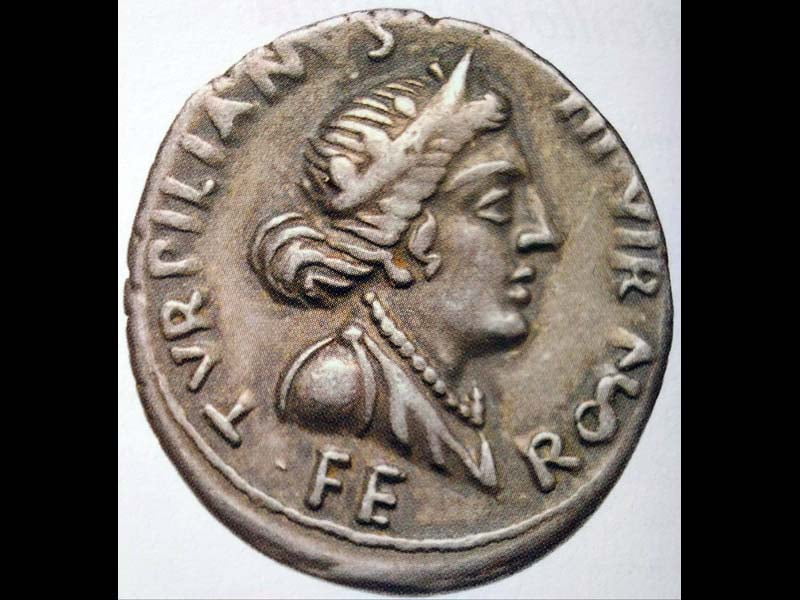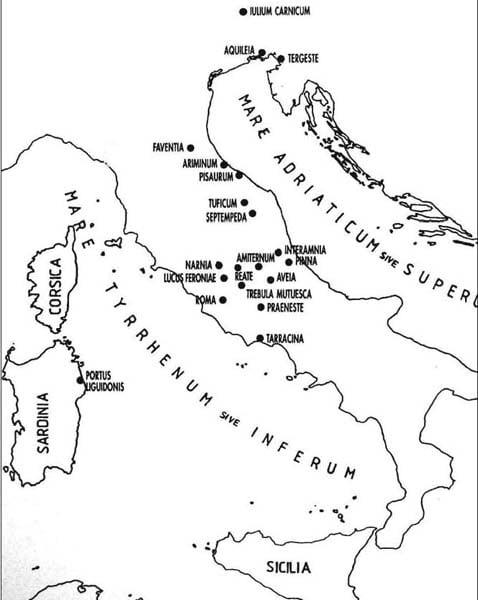di Oretta Di Carlo, Enrica Tedeschi, Susanna Magnelli, Donatella Livigni and Tatiana Melaragni
The cult of the goddess Feronia is known to us thanks to the numerous news that the authors of Latin and Greek literature have left us, to the numerous epigraphs of the classical era and also to a coin, which reproduces the face of the goddess in profile. This coin allows us to know the iconography of the goddess which recalls, in some places, that of Juno and in fact, in one of the drains of the Aeneid, Servius reports that Feronia was also called Juno Virgo.
For the diffusion of the cult of Feronia an important role was also played by roads such as the Caecilia, the Claudia Nova, the Curia and the Flaminia, which with their layouts and their byways connected the Sabine cities with many others in which Feronia was venerated (Iorio, 2016).
Numerous clues confirm the prehistoric character of Feronia as Potnia Theròn, a mythical figure who inherited the ancient Pelasgian cult of the Great Mediterranean Mother (as we learn from the research of Uberto Pestalozza and Momolina Marconi, in the 2011s and XNUMXs). The best known aspects of Feronia are connected to the Roman phase. However, scholars point out the multiple traces of the prehistoric past (G. Feo XNUMX).
The forest (lucus) and the mountain (Soratte) belong to it. Among the animals, the snake, the goat, the wolf and the woodpecker (picus feronius, connected to its parents, Jupiter and Mars). She is associated with the Etruscan sun god Sur (Apollo Sorano), who is a chthonic god. Scholars have noted overlaps and affinities with goddesses characterized by the aquatic and solar symbols of the Mediterranean Great Mother, such as Angitia, linked to the cult of snakes, or Mefitis, goddess of the marshes. They are close to her in symbology: Ops, goddess of abundance, and Fauna, goddess of the fields.
Feronia is mentioned in the Aeneid twice. In Book VII she is she in the list of allies of Turnus (Aurunci, Rutuli and Sicani). Virgil tells of the forest sacred to the goddess in the plain of Terracina. In book VIII, Feronia is mentioned as the mother of Erylus, king of Praeneste with three heads and three souls. The triplicity of Erylus constitutes an attribute of triplicity also for Feronia, evoking both the phases of the moon and the triune archetype that accompanies the ancient female divinities.
The divinity is pre-Roman: Latin, Sabina, in particular Volsca (population of northern Sabina). She was also celebrated by the Etruscans, Falisci, Capenati, Umbrians, Piceni and was incorporated into the liturgical system of the Romans. In Rome, she was celebrated on the Ides of November, together with Jupiter and Fortuna Primigenia.
His cult is not usually located within the city walls, but always outside in wild woods (with the exception of the Roman temple in the sacred area of Argentina). She is however a mediating goddess, not exclusively wild like Diana. You favor the dialogue between the forest and the city, between the cultured and the uncultured, between the manifested world and the afterlife. In summary, she between invisible and visible, with a shamanic function of passage between the worlds (L. Magini 2011).
The etymology of Feronia is explained by Dumézil on the basis of the term ferus (non cultus, agrestis), Momolina Marconi connects it to potnia theron (mistress of wild animals) through the replacement of theta with f, a Mediterranean-eastern consonant, which would make sister of Leto and Artemis. Another etymological possibility is connected to the term feralis (and to the Feralia), that is, to the underworld and chthonic world.
She is the mother of important gods (Juppiter Anxurus, Erulo, Apollo Sorano). All male deities depicted as very young, beardless: a clear reference to the archetype of the paredro, son and lover of the Great Mediterranean Mothers.
The slaves who become freedmen, that is to say freed with the institution of the manumissio, appeal to Feronia. The slave not having true human dignity, according to Roman culture, what took place in the rite of manumissio was a real birth in the form of liberation. As mediator between the order of nature and that of society, Feronia was competent in the rites of passage of status.
Feronia's oracular and prophetic trait that derives from being diva inferorum, and from maintaining a structural link with the world of the dead, should be noted.
A cave on Mount Soratte belonged to her (the remains of the church of S. Romana remain and the cave where the waters still collect can be visited), where female cults linked to fertility and breastfeeding were celebrated, in addition to oracular practices.
Several authors report that the devotees, in addition to the priests, possessed by the goddess, practiced pirobazia (the ability to walk on burning embers), which is documented above all on Mount Soratte, but it seems that it also took place at the sanctuary.
In the capenate colony of Lucus Feroniae, in Praeneste and in places of worship, the Mulieres Feronienses were devoted to the goddess. It was probably about freedoms.
In the sanctuary near the Lucus Feroniae there was a large altar (as shown by the plan of the central area) which must have been the one around which the populations who converged there gathered and its importance is testified by the fact that when Lucus Feroniae from places in the 'Ager Capenas became a real independent colony, the altar and the area surrounding it were preserved with the construction of a wall that separates them from the forum of the colony (Iorio, 2016).
The cult of the Goddess Feronia, despite having its epicenter in Sabina, exactly at km 17 of the Via Tiberina, near the Roma Nord (Fiano Romano) exit of the A1 motorway, in the municipality of Capena (in the province of Rome), is attested in much of central Italy, in Sardinia and up to the extreme north-east. Primary places of worship in Lazio are: Lucus Feroniae (Capena – Rome), Trebula Mutuesca (Monteleone Sabino – Rieti), Amiternum-Aveia (Rieti) Praeneste (Palestrina – Rome) and Tarracina (Terracina – Latina), with some offshoots in Abruzzo such as Pinna Poggio Ragone (Loreto Aprutino – Pescara).
Secondary places of worship are found in central-northern Italy, in Sardinia, along the “Flaminia” route (Umbria, Marche and Romagna), as far as Aquileia and Istria.
Oretta Di Carlo, Enrica Tedeschi, Susanna Magnelli, Donatella Livigni and Tatiana Melaragni - 2022
REFERENCES
- Vincenza Iorio - "The cult of Feronia" - in Lucus Feroniae. The sanctuary, the city, the territory – edited by Alfonsina Russo Tagliente, Giuseppina Ghini and Laura Caretta – Science and Letters – Rome 2016;
- Enrico Benelli - "The sanctuary of Feronia in the archaic age" - in Lucus Feroniae. The sanctuary, the city, the territory – edited by Alfonsina Russo Tagliente, Giuseppina Ghini and Laura Caretta – Science and Letters – Rome 2016;
- Alfonsina Russo Tagliente, Giuseppina Ghini, Laura Caretta – Lucus Feroniae. The sanctuary, the city, the territory – Sciences and Letters – Rome 2016;
- Renato Bartoccini – Colonia Iulia Felix Lucus Feroniae. Discovery and excavation of monuments – Tiberino Graphic Institute, Rome 1960;
- George Dennis – The Cities and Cemeteries of Etruria – London 1848 – Italian translation by Mario Castagnola – Etruscan Itineraries – De Luca, Rome 1984;
- Massimiliano Di Fazio – Feronia. Spaces and times of a goddess of ancient central Italy – Quasars – Rome 2013;
- Massimiliano Di Fazio (2017) – “Angizia, Feronia, Marica: Italic divinities and cults in the Aeneid” – in Mélanges de l'Ecole française de Rome - 129/1 - 2017;
- Massimiliano Di Fazio – “The places of worship of Feronia. Locations and functions” – in Proceedings of the XIX International Conference on the History and Archeology of Etruria –2016;
- Giuseppe Maria Della Fina (edited by) - "The Fanum Voltumnae and the Community Sanctuaries of Ancient Italy" - in Proceedings of the XIX International Conference on the History and Archeology of Etruria –2016;
- Gianfranco Gazzetti – Lucus Feroniae – Didactic notebooks – Rome 1998;
- Momolina Marconi – Mediterranean reflections in the oldest religion of Lazio – Principality – Messina-Milan 1939;
- Momolina Marconi – From Circe to Morgana – edited by Anna De Nardis – Venexia publisher – 2009;
- Uberto Pestalozza (1996) – Eternal Mediterranean feminine – edited by Pier Angelo Carozzi – Vicenza 1996;
- Stephan Steingraber – Cities and necropolises of Etruria – Newton Compton – Rome 1983;
- Lily Ross Taylor (1920) – “The Site of Lucus Feroniae” – in The Journal of Roman Studies – Vol. 10 – Society for the Promotion of Roman Studies Stable, 1920 – pp. 29-36;
- For the voice "Feronia” by William Smith – Dictionary of Greek and Roman Biography and Mythology – London 1870;
- For the voice "Feronia” by Charles Godfrey Leland – Etruscan Roman Remains in popular tradition – New York 1892;
- For Nica Fiori – “Goddesses, priestesses, sorceresses: Feronia and the archaeological site of Lucus Feroniae"
- Conference "Feronia: the Divinity, the places of worship and its liturgies" held at the Orsini Castle in Fiano Romano (RM) on 22 October 2011:
- Speech by Emanuela Chiavarelli, "Survey on the Goddess Feronia";
- Speech by Luigi Pellini, “Pre-Christian traditions of the Veneto";
- Intervention by Giovanni Feo, “The Etruscan territory of Feronia and Sorano";
- Speech by Leonardo Magini, "Feronia and Fortuna, shamanism in ancient Rome";
- Intervention of Renato DelPonte, moderator.





A thought on "Feronia and its cult – Capena (RM)"
Comments are closed.